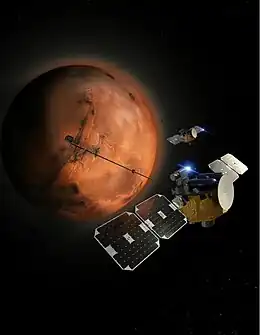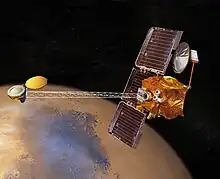 Render of 2 EscaPADE Spacecraft | |
| Mission type | Mars orbiter |
|---|---|
| Website | escapade |
| Spacecraft properties | |
| Spacecraft | Blue and Gold |
| Manufacturer | Rocket Lab |
| Power | Solar panels |
| Start of mission | |
| Launch date | 6−15 August 2024 (planned)[1] |
| Rocket | New Glenn |
| Launch site | Cape Canaveral LC-36 |
| Contractor | Blue Origin |
Escape and Plasma Acceleration and Dynamics Explorers (EscaPADE) is a planned spacecraft mission to Mars consisting of two spacecraft known as Blue and Gold.[2][3] The mission, expected to launch in August 2024, is part of NASA's SIMPLEx program.[1][4]
Mission
EscaPADE is led by Principal Investigator Dr. Robert Lillis and colleagues at the University of California, Berkeley. The spacecraft is being built by Rocket Lab based on their "Photon" spacecraft bus.[5] At an anticipated cost of $79 million (including launch vehicle), the mission will demonstrate low cost planetary space exploration. The twin spacecraft will study Mars' unique magnetosphere and how solar wind contributed to the loss of most of the planet's atmosphere over solar system history.
Launch
The Small Innovative Missions for Planetary Exploration ("SIMPLEx") program[6] was intended as a program to select small, low-cost space missions to fly as secondary payloads on other NASA missions. As a ride-along mission on another launch, not a main mission, they were intended to have low cost and tolerate a higher level of risk than other NASA missions.
EscaPADE was originally selected from a competition to be a low-cost ride-along "mission of opportunity" to hitch a ride to Mars with the Psyche spacecraft, and drop off as the spacecraft made a fly-by of Mars. Thus, it had an anticipated launch cost of nearly nothing. However, the launch of the Psyche mission was delayed, which meant that when Psyche passes the orbit of Mars, Mars is no longer near the trajectory of Psyche.[6] Rather than cancel the mission, NASA announced that it would go on a different launch vehicle, and requested bids from industry for the launch.
In February 2023, Blue Origin won the contract to launch the mission on the first flight of the New Glenn launch vehicle in 2024, at a cost of $20 million.[4]
Spacecraft
Each identical EscaPADE spacecraft has a dry mass of ~200 kg, with a wet mass of <550 kg. The spacecraft bus is originally adapted from the Rocket Lab Photon third stage and is approximately 60 x 70 x 90 cm. The spacecraft is powered by two 480 x 70 cm solar array wings. Chemical propulsion is provided by thrusters from ArianeSpace.[7] Reaction wheels, inertial measurement units, and star trackers are used to maintain orientation, with cold gas thrusters to desaturate the wheels. Communications are in X-band via a 60 cm diameter dish antenna. A 200 cm boom extends above the spacecraft, hosting the EMAG and ELP mNLP sensors.[3]
After launch, EscaPADE spend approximately six weeks in Earth orbit before executing a trans-Mars injection (TMI) in October 2024. The twin probes will reach Mars in September 2025 and go into a highly elliptical orbit. Over the following six months the orbit will be lowered and circularized until it reaches the nominal science orbit.
Instruments and science goals
The science goals of EscaPADE are to:[3]
- understand the processes controlling the structure of Mars' hybrid magnetosphere and how it guides ion flows;
- understand how energy and momentum are transported from the solar wind through Mars' magnetosphere;
- understand the processes controlling the flow of energy and matter into and out of the collisional atmosphere.
There are three science experiments onboard each identical spacecraft, EMAG, EESA, and ELP. EMAG is a magnetometer that will measure DC magnetic fields up to 1000 nT, mounted at the end of the boom to reduce magnetic noise from the spacecraft. EESA is an electrostatic analyzer designed to measure the energies, fluxes, and masses of suprathermal ions from 2 eV to 20 keV and energies and fluxes of suprathermal electrons from 3 eV to 10 keV. It is mounted on the upper deck of the spacecraft bus, with a 240° x 120° field of view for electrons and 247.5° x 90° field of view for ions. ELP is a Langmuir probe, consisting of three separate sensors: the multi-needle Langmuir probe (mNLP) consists of 4 thin needles mounted in two pairs ~3/4 way up the boom and measures thermal electron density; the two planar ion probes (PIPs) are mounted on the instrument deck and measure thermal ion density, and the floating potential probe (FPP) is also mounted on the spacecraft deck, and measures changes in relative spacecraft electrostatic potential.
Once the nominal science orbit is achieved, approximately six months after arriving at Mars, Science Campaign A involves both spacecraft flying in the same orbit at varying distance from one another, ~170 x 8400 km (5.66 hours) with an inclination of 65 degrees. This will last approximately 6 months, at which time Blue will lower its apoapsis to 7000 km and Gold will raise its apoapsis to 10,000 km. With different orbital periods (4.9 and 6.6 hours), the orbits will precess (due to Mars' nonuniform gravity field) at different rates, and thus separate, allowing simultaneous measurements of distant parts of the Mars magnetosphere. This campaign will operate for approximately 5 months, until the end of the nominal science mission in early March 2027.[3]
Further reading
See also
References
- 1 2 Foust, Jeff (13 April 2023). "ESCAPADE confident in planned 2024 New Glenn launch". SpaceNews. Retrieved 14 April 2023.
- ↑ Sanders, Robert (2021-08-23). "'Blue' and 'Gold' satellites headed to Mars in 2024". Berkeley News. Retrieved 2023-02-11.
- 1 2 3 4 "NASA – NSSDCA – Spacecraft – Details". NSSDC. NASA. Retrieved 2023-02-11.
 This article incorporates text from this source, which is in the public domain.
This article incorporates text from this source, which is in the public domain. - 1 2 Clark, Robert (Nov. 22, 2023). "NASA will launch a Mars mission on Blue Origin’s first New Glenn rocket", Ars Technica. Retrieved 23 Nov. 2023.
- ↑ Hatfield, Miles (August 20, 2021). "NASA’s ESCAPADE Mission – Twin Martian Orbiters – Moves Toward Launch," NASA. Retrieved 23 Nov. 2023.
- 1 2 Foust, Jeff (February 20, 2023). "Trials and tribulations of planetary smallsats", The Space Review. Retrieved 23 Nov. 2023.
- ↑ 73 International Astronautical Congress (IAC) (18 September 20022), ESCAPADE: A Low-Cost Formation at Mars, Retrieved 21 October 2023

.jpg.webp)
.jpg.webp)